It's no myth — Icarus made a rare flyby of Earth this week.

Ya burnt! That would probably be today's cheeky reaction to Icarus's ill-fated flight. In the Greek myth, Icarus and his father, Daedalus, attempt to flee Crete by building wings of wax and feathers. On departing, Daedalus cautions his son to fly neither too low above the sea nor too high, lest the Sun melt the wax and cause the wings to fall apart. Icarus gets caught up in the thrill of flying and ignores his father's warning. When the wax melts, he plunges to his death in the sea.
The overly confident son may have passed on, but his asteroid namesake, 1566 Icarus, lives. It was discovered by none other than Walter Baade (of Baade's Window fame) on June 27, 1949, at Palomar Observatory in California.
In what has to be one of the most fitting names ever given an asteroid, Icarus was chosen because it passes close enough to the Sun that any imagined feathers and wax would have long ago burned away in the ferocious heat. With one of the closest perihelion distances known — just 20 solar diameters, or 17.4 million miles — the 0.9-mile-wide (1.4 km) asteroid gets cooked to nearly 1000°F (526°C)!
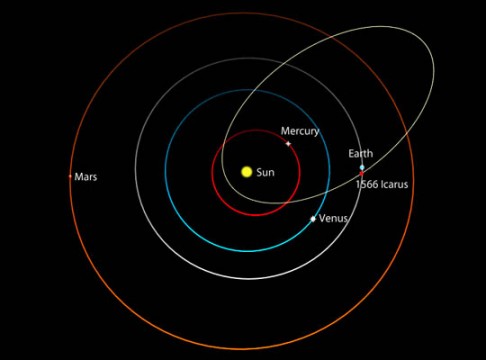
Software Bisque - The Sky / Gianluca Masi
This week it makes one of its rare close approaches of Earth at a distance of 5 million miles, the closest it's been since June 14, 1968, when it passed just 3.8 million miles away.
Closest approach occurs today (June 16) around 10:39 a.m. Central Daylight Time. Tonight, the asteroid will only shine as bright as magnitude +13.9, but it's well-placed in a moonless sky in Canes Venatici, off the Big Dipper's Handle. Over the following evenings, it moves southward across Coma Berenices and Bootes and brightens to magnitude +13.5. The charts below show detailed positions for June 16-19, but Icarus remains brighter than magnitude +14 through the first day of summer.
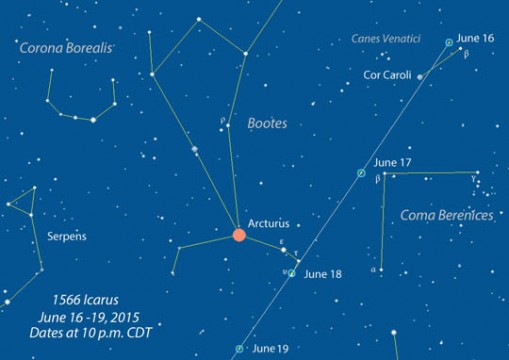
Chris Marriott's SkyMap
For the next couple days, the asteroid will be moving at about 3/4° per hour, making its motion across the star field obvious within a few minutes at medium magnification. When seeking a relatively fast and faint moving object like Icarus, give yourself plenty of time to identify the star field it's expected to pass through at a selected time, then lie in wait for it to appear. The eye can quickly identify an interloper, particularly one moving at a reasonably fast clip.
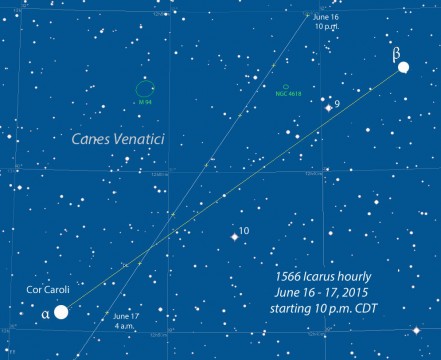
Chris Marriott's SkyMap
Icarus was the first asteroid to be observed using radar during that close 1968 apparition. Based on data gleaned from bouncing radio waves off the object, as well as conventional visual observations, we know it spins rapidly with a period of 2.27 hours and exhibits small changes in brightness amounting to +0.2 magnitude over a rotation period. Reflectance spectra place Icarus among the relatively rare Q-class inner belt asteroids with a composition of olivine, pyroxene, and iron-nickel — a good match for ordinary chondrites, which make up the bulk of the stony meteorites found on Earth.
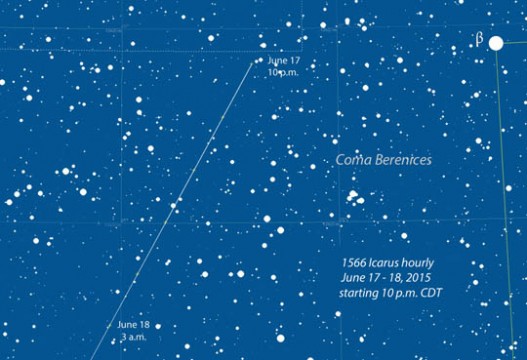
Chris Marriott's SkyMap
Because Icarus's orbit is highly eccentric with a relatively steep inclination of 22.8°, some astronomers suspect it might be related to comets, which we know exhibit all manner of eccentricities. In 1968, Tom Gehrels and team looked closely for a coma but found none. However, they dangled the question as to whether the asteroid might be an "exhausted cometary nucleus that has lost the power to release volatiles on approach to the Sun." Perhaps another look is warranted this time around?
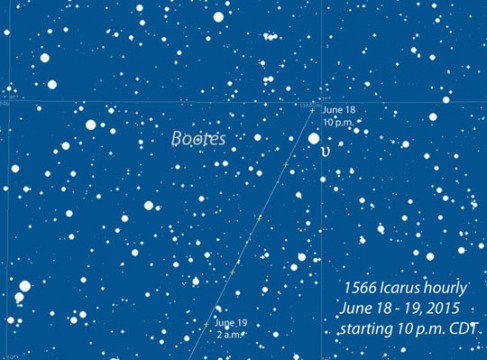
Chris Marriott's SkyMap
Amateur and professional astronomers alike will be watching Icarus this week with both telescopes and radar. Observations are scheduled at NASA's Goldstone facility in California's Mojave Desert from June 13-17 and also possibly at the big Arecibo dish in Puerto Rico June 17-21. Icarus will be close enough to beam signals to, for study upon their return. Analysis of the reflected signal should yield Doppler images of Icarus and allow scientists to determine its three-dimensional shape.
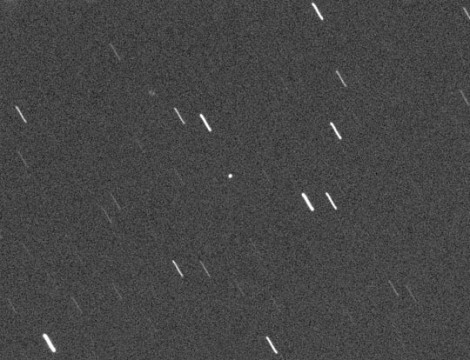
Gianluca Masi
Don't have a dish or telescope? Italian astronomer Gianluca Masi will stream live images of the asteroid on his Virtual Telescope Project website beginning at 4:30 p.m. CDT (21:30 UT) today (June 16, 2015). This will give everyone an opportunity to see the minor planet during this rare flyby.
Mythical Icarus may not have followed his father's advice, but Icarus re-incarnated as a mile-wide space rock can't help but obey something even more powerful — Sir Isaac's Laws of Motion and Gravity.
Like going deep? We've created a Deep-Sky Observing Collection just for you!
 0
0









Comments
You must be logged in to post a comment.